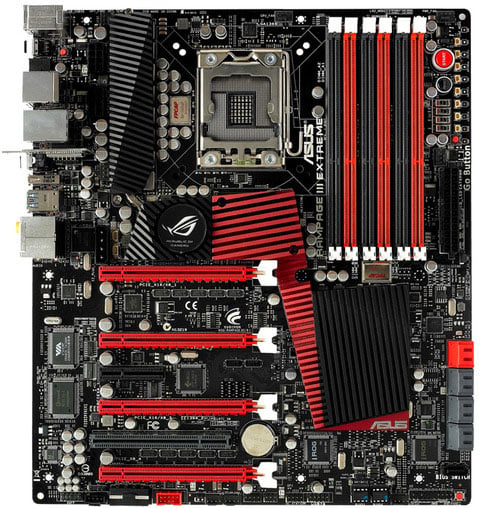Mobo To The Max: Asus Launches Its Rampage III Extreme
Asus has another
addition for its Rampage line of high-end motherboards. This time around
it's the Rampage III Extreme, otherwise known as the Rampage III "All
That + Back Of Chips." It's not as if the company's Rampage II Extreme
was exactly lacking in features, but here we have the Rampage III with a
few goodies the Rampage
II didn't carry.
Specifically, the Rampage III carries four PCIe 2.0 slots (configurable in combinations of x16/x16 down to four x8 lanes), a total of nine SATA ports, two of which are 6G-compatible, eight fan headers, two USB 3.0 ports, and it comes with full versions of 3DMark Vantage and Kaspersky antivirus. That's one more PCIe slot, two more SATA ports, and two USB 3.0 ports more than the Rampage II. Oddly, the Rampage III has just one ethernet port while the Rampage II has two. Personally I'd trade the rear FireWire for an additional RJ-45, but that's just me.

The Rampage II has been out for awhile, but it still sells for $349. Asus probably won't pull the Rampage II right away, at least not without taking a shot at positioning the Rampage III as a $399 ultra-super-premium-mega-board. That price is a guess, but version 3.0 packs enough new features over and above 'II that it might be worth a shot.

One thing to keep in mind is that the USB 3.0 and SATA 6G slots are powered by first-gen controllers from NEC and Marvell (D720200 and the 88SE9123 respectfully). In both cases, the two ports available for each interconnect share a host controller; attempting to use a pair of USB 3.0 devices (or dual SATA 6G drives) will result in a performance hit as the controller juggles both lanes. The other issue is bandwidth. Again, both controllers connect to the motherboard via a PCIe x1 Gen 2 electrical link that limits maximum theoretical bandwidth (discounting overhead) to 400MB/s.
These limitations are common in first-generation parts, and most users probably won't notice—50 percent of USB3 theoretical performance is still 5x faster than USB2. Still, if you're the type of reader who can drop $400 on a motherboard, you're probably also the type of person who could drop serious cash for high-end storage solutions.
Specifically, the Rampage III carries four PCIe 2.0 slots (configurable in combinations of x16/x16 down to four x8 lanes), a total of nine SATA ports, two of which are 6G-compatible, eight fan headers, two USB 3.0 ports, and it comes with full versions of 3DMark Vantage and Kaspersky antivirus. That's one more PCIe slot, two more SATA ports, and two USB 3.0 ports more than the Rampage II. Oddly, the Rampage III has just one ethernet port while the Rampage II has two. Personally I'd trade the rear FireWire for an additional RJ-45, but that's just me.

The Rampage II has been out for awhile, but it still sells for $349. Asus probably won't pull the Rampage II right away, at least not without taking a shot at positioning the Rampage III as a $399 ultra-super-premium-mega-board. That price is a guess, but version 3.0 packs enough new features over and above 'II that it might be worth a shot.

One thing to keep in mind is that the USB 3.0 and SATA 6G slots are powered by first-gen controllers from NEC and Marvell (D720200 and the 88SE9123 respectfully). In both cases, the two ports available for each interconnect share a host controller; attempting to use a pair of USB 3.0 devices (or dual SATA 6G drives) will result in a performance hit as the controller juggles both lanes. The other issue is bandwidth. Again, both controllers connect to the motherboard via a PCIe x1 Gen 2 electrical link that limits maximum theoretical bandwidth (discounting overhead) to 400MB/s.
These limitations are common in first-generation parts, and most users probably won't notice—50 percent of USB3 theoretical performance is still 5x faster than USB2. Still, if you're the type of reader who can drop $400 on a motherboard, you're probably also the type of person who could drop serious cash for high-end storage solutions.

